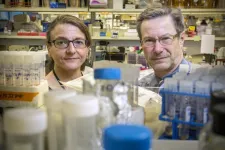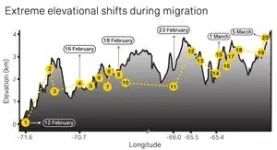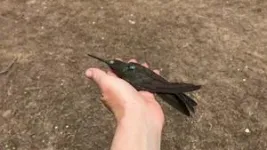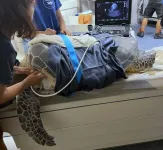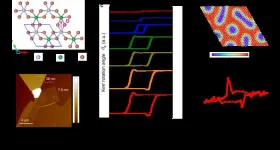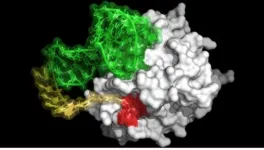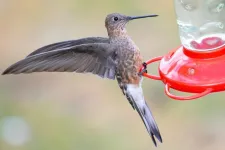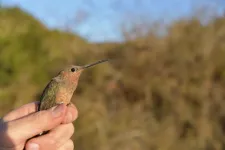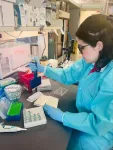(Press-News.org) SEATTLE — May 13, 2024 — Researchers at Fred Hutch Cancer Center have found in pre-clinical studies that an experimental gene therapy for genital and oral herpes removed 90% or more of the infection and suppressed how much virus can be released from an infected individual, which suggests that the therapy would also reduce the spread of the virus.
“Herpes is very sneaky. It hides out among nerve cells and then reawakens and causes painful skin blisters,” said Keith Jerome, MD, PhD, professor in the Vaccine and Infectious Disease Division at Fred Hutch. “Our aim is to cure people of this infection, so that they don’t have to live with the worry of outbreaks or of transmitting it to another person.”
Published May 13 in Nature Communications, Jerome and his Fred Hutch team published an encouraging step toward a gene therapy for herpes.
The experimental gene therapy involves injecting into the blood a mixture of gene editing molecules that seek out where the herpes virus resides in the body. The mixture includes laboratory-modified viruses called a vector — commonly used in gene therapies — plus enzymes that work like molecular scissors. Once the vector reaches the clusters of nerves where the herpes virus hangs out, the molecular scissors snip away at the herpes virus’s genes to damage them or remove the virus entirely.
“We are using a meganuclease enzyme that cuts in two different places in the herpes virus’s DNA,” said first author Martine Aubert, PhD, principal staff scientist at Fred Hutch. “These cuts damage the virus so much that it can’t repair itself. Then the body’s own repair systems recognize the damaged DNA as foreign and get rid of it.”
Using mouse models of the infection, the experimental therapy eliminated 90% of herpes simplex virus 1 (HSV-1) after facial infection, also known as oral herpes, and 97% of herpes HSV-1 after genital infection. It took about a month for the treated mice to show these reductions, and the reduction of virus seemed to get more complete over time.
In addition, the researchers found that the HSV-1 gene therapy had a significant reduction in both the frequency and amount of viral shedding.
“If you talk to people living with herpes, many are worried about whether their infection will transmit to others,” Jerome said. “Our new study shows that we can reduce both the amount of virus within the body and how much virus is shed.”
The Fred Hutch team also simplified their gene editing treatment, making it safer and easier to make. In a 2020 study, they used three vectors and two different meganucleases. The latest study uses just one vector and one meganuclease capable of cutting the virus DNA in two places.
“Our streamlined gene editing approach is effective at eliminating the herpes virus and has less side effects to the liver and nerves,” Jerome said. “This suggests that the therapy will be safer for people and easier to make, since it has fewer ingredients.”
While the Fred Hutch scientists are encouraged by how well the gene therapy works in animal models and are eager to translate the findings to treatments for people, they are also careful about the steps needed to prepare for clinical trials. They also noted that though the current study examined HSV-1 infections, they are working on adapting the gene editing technology to target HSV-2 infections.
“We’re collaborating with numerous partners as we approach clinical trials so we align with federal regulators to ensure safety and effectiveness of the gene therapy,” Jerome said. “We deeply appreciate the support of herpes advocates as they share our vision for curing this infection.”
Herpes simplex virus (HSV) is a common infection that lasts a lifetime once people are infected. Current therapies can only suppress but not completely eliminate symptoms, which include painful blisters. According to the World Health Organization, an estimated 3.7 billion people under the age of 50 (67%) have HSV-1, which causes oral herpes. An estimated 491 million people aged 15-49 (13%) worldwide have HSV-2, which causes genital herpes.
Herpes can create other harms to people’s health. HSV-2 increases the risk of acquiring HIV infection. Other studies have linked dementia with HSV-1.
The work was funded by the National Institutes of Health, the Caladan Foundation and more than 2,000 donors. The meganucleases used in this research are derivatives of commercially-available meganucleases.
Note: Scientists at Fred Hutch played a role in developing these discoveries, and Fred Hutch and certain of its scientists may benefit financially from this work in the future.
###
Media contact:
Molly McElroy
mwmcelro@fredhutch.org
Fred Hutchinson Cancer Center unites individualized care and advanced research to provide the latest cancer treatment options while accelerating discoveries that prevent, treat and cure cancer and infectious diseases worldwide.
Based in Seattle, Fred Hutch is an independent, nonprofit organization and the only National Cancer Institute-designated cancer center in Washington. We have earned a global reputation for our track record of discoveries in cancer, infectious disease and basic research, including important advances in bone marrow transplantation, immunotherapy, HIV/AIDS prevention and COVID-19 vaccines. Fred Hutch operates eight clinical care sites that provide medical oncology, infusion, radiation, proton therapy and related services. Fred Hutch also serves as UW Medicine’s cancer program.
END
Herpes cure with gene editing makes progress in laboratory studies
Fred Hutch virologists eliminated at least 90% of HSV-1 in preclinical models of oral and genital herpes and reduced viral shedding in a study published in Nature Communications
2024-05-13
ELSE PRESS RELEASES FROM THIS DATE:
Catch and release can give sea turtles the bends #ASA186
2024-05-13
OTTAWA, Ontario, May 13, 2024 – Six out of seven sea turtle species are endangered, and humans are primarily responsible. Commercial fishing activities are the largest human-caused disturbance to sea turtles due to accidental capture.
Fishers are typically unaware if a sea turtle is caught in their net until it’s completely pulled out of the water. However, releasing sea turtles without veterinary evaluations can be harmful. When accidentally caught, the turtles’ normal diving processes are interrupted, ...
Researchers unveil unique tidal disruption event with unprecedented early optical bump
2024-05-13
A research team from the University of Science and Technology of China (USTC) of the Chinese Academy of Sciences (CAS) presented a detailed analysis of a tidal disruption event (TDE) with unique characteristics, providing new insights into the behavior of TDEs and their multiwavelength emissions. The study was published online in The Astrophysical Journal Letters.
When a star ventures too close to a supermassive black hole at the center of a galaxy, it gets torn apart by the black hole's immense tidal forces, resulting ...
Researchers discover "topological hall effect" in two-dimensional quantum magnets
2024-05-13
In a recent study published in Nature Physics, researchers from the Hefei Institutes of Physical Science of the Chinese Academy of Sciences, together with researchers of University of Science and Technology of China, have introduced the concept of the "Topological Kerr Effect" by using the low-temperature magnetic field microscopy system and the magnetic force microscopy imaging system supported by the steady-state high magnetic field experimental facility.
The study holds great promise for advancing our understanding of topological magnetic ...
Like dad and like mum…all in one plant
2024-05-13
In a new study, led by Charles Underwood from the Max Planck Institute for Plant Breeding Research (MPIPZ) in Cologne, Germany, scientists established a system to generate clonal sex cells in tomato plants and used them to design the genomes of offspring. The fertilization of a clonal egg from one parent by a clonal sperm from another parent led to plants containing the complete genetic information of both parents. The study is now published in Nature Genetics.
Hybrid seeds, combining two different parent lines with specific favorable traits, are popular in agriculture as they give rise to robust crops with enhanced productivity, and have been utilized by farmers ...
New molecule mimics the anti-clotting action of blood-sucking organisms
2024-05-13
DURHAM, N.C. – Nature gave ticks, mosquitos and leaches a quick-acting way to keep blood from clotting while they extract their meal from a host.
Now the key to that method has been harnessed by a team of Duke researchers as a potential anti-clotting agent that could be used as an alternative to heparin during angioplasty, dialysis care, surgeries and other procedures.
Publishing in the journal Nature Communications, the researchers describe a synthetic molecule that mimics the effects of compounds in the saliva of blood-sucking critters. Importantly, the new molecule can also ...
Transgender preteens report 13 hours of daily screen time
2024-05-13
Toronto, ON - A new national study found that transgender preteens, 12 and13 years old, reported 13 hours of daily recreational screen time, which was 4.5 hours more than their cisgender peers. Data were collected from 2019 to 2021, overlapping with the COVID-19 pandemic, and the study was published in Annals of Epidemiology.
“Transgender adolescents are more likely to experience school-based bullying and exclusion from peer groups due to their gender identity, leading them to spend less time in traditional school activities and more time on screens,” says lead author, Jason Nagata, MD, associate professor of pediatrics at the University of California, San Francisco. ...
World's largest hummingbird is actually two species
2024-05-13
For release: May 13, 2024
Ithaca, NY—The Giant Hummingbird of western South America is not one species but two, according to an international group of researchers. The northern population stays in the high Andes year-round while the southern population migrates from sea level up to 14,000 feet for the nonbreeding months. The two species appear identical. But looks deceive—their genomes and behaviors tell a different story. The paper announcing the find was published this week in the journal Proceedings of the National Academy of Sciences.
“These ...
New findings released from US 2020 Facebook and Instagram election study
2024-05-13
In the weeks before and after the 2020 presidential election, researchers ran a number of tests to try to understand how much Facebook and its corporate cousin, Instagram, may be contributing to the nation's political divide.
One of those experiments — led by Matthew Gentzkow and Hunt Allcott, economics professors at Stanford University — centered on more than 35,000 Facebook and Instagram users who were paid to stay off the platforms in the run-up to Election Day. There’s a lot that researchers could glean from the social media hiatus, including whether people’s political attitudes shifted and in what ways. If views changed dramatically, that ...
How miniature backpacks led to the discovery of the world’s largest hummingbird species
2024-05-13
Researchers from UNM’s Museum of Southwestern Biology (MSB) have uncovered the giant hummingbird’s extreme long-distance migration for the first time. Their eight-year study, Extreme elevational migration spurred cryptic speciation in giant hummingbirds published this week in Proceedings of the National Academy of Sciences, led them to another important discovery: The world’s largest hummingbird is a new species.
The team, led by Jessie Williamson, UNM Ph.D., 2022, included the Museum of Southwestern Biology at UNM, Pontificia Universidad Católica de Chile in Chile, and Centro de Ornitología ...
New synthetic biomarker technology differentiates between prior Zika and dengue infections
2024-05-13
A newly discovered Zika virus-specific synthetic molecule is capable of differentiating Zika-immune patient samples from samples of patients previously infected with the related dengue virus. The technology may lead to the development of better diagnostics and vaccine candidates, scientists announced today in the Proceedings of the National Academy of Sciences.
The study, led by researchers at the University of Pittsburgh School of Public Health and The Herbert Wertheim UF Scripps Institute for Biomedical Innovation & Technology, is the first to apply an innovative “epitope surrogate” technology to Zika. Until now, researchers and clinicians have lacked diagnostic ...
LAST 30 PRESS RELEASES:
Injectable breast ‘implant’ offers alternative to traditional surgeries
Neuroscientists devise formulas to measure multilingualism
New prostate cancer trial seeks to reduce toxicity without sacrificing efficacy
Geometry shapes life
A CRISPR screen reveals many previously unrecognized genes required for brain development and a new neurodevelopmental disorder
Hot flush treatment has anti-breast cancer activity, study finds
Securing AI systems against growing cybersecurity threats
Longest observation of an active solar region
Why nail-biting, procrastination and other self-sabotaging behaviors are rooted in survival instincts
Regional variations in mechanical properties of porcine leptomeninges
Artificial empathy in therapy and healthcare: advancements in interpersonal interaction technologies
Why some brains switch gears more efficiently than others
UVA’s Jundong Li wins ICDM’S 2025 Tao Li Award for data mining, machine learning
UVA’s low-power, high-performance computer power player Mircea Stan earns National Academy of Inventors fellowship
Not playing by the rules: USU researcher explores filamentous algae dynamics in rivers
Do our body clocks influence our risk of dementia?
Anthropologists offer new evidence of bipedalism in long-debated fossil discovery
Safer receipt paper from wood
Dosage-sensitive genes suggest no whole-genome duplications in ancestral angiosperm
First ancient human herpesvirus genomes document their deep history with humans
Why Some Bacteria Survive Antibiotics and How to Stop Them - New study reveals that bacteria can survive antibiotic treatment through two fundamentally different “shutdown modes”
UCLA study links scar healing to dangerous placenta condition
CHANGE-seq-BE finds off-target changes in the genome from base editors
The Journal of Nuclear Medicine Ahead-of-Print Tip Sheet: January 2, 2026
Delayed or absent first dose of measles, mumps, and rubella vaccination
Trends in US preterm birth rates by household income and race and ethnicity
Study identifies potential biomarker linked to progression and brain inflammation in multiple sclerosis
Many mothers in Norway do not show up for postnatal check-ups
Researchers want to find out why quick clay is so unstable
Superradiant spins show teamwork at the quantum scale
[Press-News.org] Herpes cure with gene editing makes progress in laboratory studiesFred Hutch virologists eliminated at least 90% of HSV-1 in preclinical models of oral and genital herpes and reduced viral shedding in a study published in Nature Communications
